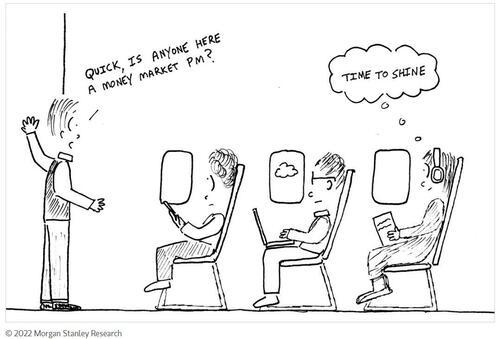Morgan Stanley: Cash Looks “Relatively Attractive” Right Now
By Andrew Sheets, Chief Cross-Asset Strategist for Morgan Stanley
Sunday Start: What If Holding Cash Is Just Efficient Asset Allocation?
Since mid-2009, a question that seems easy in hindsight and but felt difficult at the time was what to do with cash. On the one hand, it didn’t yield anything, and allocating to anything else usually did better. But the last 12 years have also been a period of profound pessimism – on the outlook for banking, Europe and long-term growth. The intensity of the GFC and the events that followed meant that in the darkest moments more than a few CFOs and investors likely mumbled a silent prayer: If we make it through this, we will never be caught without liquidity again.
Holding cash, in other words, was an explicitly defensive decision for much of the last 12 years. Of course it offered a worse return than anything else in the market. That was the point. Holding cash was the price of security, an insurance policy against that prevailing gloom. And like insurance, it could be expensive. USD cash underperformed both the S&P 500 and the US 10-year every year from 2010 to 2020 except two (2013 and 2018).
But the idea that holding cash means paying for insurance is no longer accurate. US 6-month T-bill yields (3.1%) are the highest since late 2007 and offer 157bp more than the dividends of the S&P 500, 21bp more than US 10-year Treasuries and just 60bp less than the US Aggregate Bond index. For USD investors, cash has ceased to be a material drag on a portfolio’s current yield.
The numbers may be less extreme in Europe, but still represent a change of regime. German 6-month bill yields, at +0.3%, are positive for the first time since 2014. For the last eight years, holding ‘cash’ in Europe cost a significant amount of money. Not anymore.
All of this has a number of implications.
First, we think that holding USD cash looks relatively attractive on a cross-asset basis. It offers a high current yield. It offers liquidity. If offers a better 12-month total return than our strategy forecasts imply for US equities, US Treasuries and either US IG or HY credit (with considerably less volatility). As a result, our Core+ optimized fixed income portfolios (see Cross-Asset Dispatches: AGG+ and CORE+ Optimal Fixed Income Portfolios: July 2022, July 29, 2022) are generally OW short-dated fixed income. USD cash also performs well versus other currencies; our FX strategists project further USD strength, especially against EUR, aided in part by the dollar’s attractive yield. One exception is EM sovereign debt, which should outperform cash, and which we’ve recently raised to OW (see Cross-Asset Dispatches: Bears Watching, August 5, 2022, and EM Sovereign Credit Strategy: Dialing Risk Up Another Notch, August 10, 2022).
Second, high yields on short-term safe assets create a risk of outflows that needs to be monitored, as it reduces the cost for investors to step out of the market. For the moment, we are more relaxed about outflows (see Cross-Asset Dispatches: More Relaxed about Outflows, July 29, 2022), given strong consumer finances, better recent cross-asset performance and the simple fact that terrible 1H performance didn’t trigger a rush for the proverbial exits.
Third, and another factor that may be limiting outflows, is that not all ‘cash’ is created equal. While US 6-month T-bills yield ~3.1%, the yields on 6-month US bank CDs are just 0.9% (and the Bankrate.com average for a US bank savings account is just 0.13%). For gathering assets and adding yield, it seems like an unusually good time to add value with money market strategies. This also raises some interesting questions around bank net interest margins, and it seems appropriate to note that the price/book ratio of EU banks was 57% higher the last time German bill yields were positive.
For much of the last 12 years, cash yielded nothing, and allocating to it represented a deliberate choice to pay an often high price for insurance. But times change. Cash yields have risen sharply at a time when Morgan Stanley’s forecasts for global cross-asset returns are low, squeezed by tighter policy if economic data continue to hold up, and higher risk premiums if the data turn down. The market is giving investors the opportunity to earn ~3% on safe, liquid T-bills, or ~5% on safe (but less liquid) short-duration CLO AAAs, and somewhere in-between for other AAA securitized paper that has cheapened as banks have faced RWA constraints. These aren’t the most exciting investments, but sometimes it makes sense to take what the market gives you.
Tyler Durden
Sun, 08/21/2022 – 16:30

